- Home
- Rural Development
- Nature Trails
- Nature Trails
- Central Sector
- Valle del Eresma
Section 3: Nava de la Asunción - Olmedo
Description

Extensive cluster pine forests and fine examples of Mudéjar art lend colour to this old railway route.
The verses of the poet Gil de Biedma said farewell to the railway in Nava la Asunción, after which the train penetrated deep into extensive masses of cluster pine forest, crossing the bridge over the river Voltoya near the Segovian municipality of Coca, an old Roman settlement and the birth place of Theodosius the Great. Mudeéjar art is well represented in both Coca and the Olmedo (Valladolid), famously once immortalised in Lope de Vega's El caballero de Olmedo.
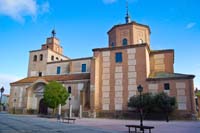
This third and final section begins where the last ended, at kilometre point 48, in the locality of Nava de la Asunción in the province of Segovia, where the expanse of cluster pine forests spreads out (Pinus pinaster) before you. These forests were and remain today an important element of the local economy. The peace and harmony of the streets of Nava de la Asunción serve as inspiration for the writer Jaime Gil de Biedma who spent long periods living in the village.
Our itinerary begins as we cross provincial road SG-V-3413 before passing the old station of Nava de la Asunción, still in perfect condition, on the right. In the past the building provided accommodation to those travelling on the railway and today houses a museum, Estación de Encuentro Jaime Gil de Biedma, dedicated to the area’s famous poet.
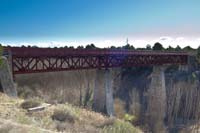
After crossing another road, this time the SG-342, we reach the Nava de la Asunción rest area and return to the original old railway line, continuing parallel with SG-P-3432 before finally crossing it, with all the necessary precautions, by the ceramics factory.
Without further ado, we leave the dry crop fields behind and enter a huge cluster pine forest that offers a landscape commensurate with the socio-economic importance of these trees, as the extraction of the resin is a key sector of the economy in this rural area. The “cat faces” or cuts on the trees, through which the resin is extracted using a chemical stimulation method, gives the pines their unique colour somewhere between orange and yellow at the lower part of the trunk and makes for an explosion of colour.
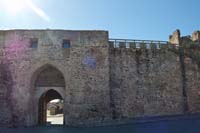
This beautiful polychrome from the pines delights the senses as the trail slowly approaches the Madrid-Valladolid AVE (high-speed railway) line which runs along part of the old railway which occupied this line.
After crossing the AVE via an underpass, the route continues in parallel with it before reaching the striking bridge over the river Voltoya, which is 110 m, crossing the river just before it flows into the river Eresma.
Cluster pine forests continue to dominate the landscape, but by now the trail has in fact penetrated Public Use Forest No. 104, called El Cantosal. The old Coca station, of which only the ruins of its storeroom remain today, and new rest area are worthy of a stop.
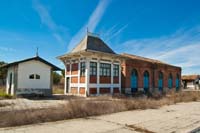
After crossing the road from Coca to Villagonzalo de Coca there lies another building in ruins, this time a much more modern construction and one which also served as a railway station. At this point the municipality of Coca is some two kilometres away. This village in the province of Segovia was once the Roman settlement of Cauca, and the birthplace of the emperor Theodosius the Great. Its rich history and architectural heritage, highlights of which include a Mudeéjar castle, medieval walls and the tower of San Nicolás are its biggest attractions.Returning to our itinerary, an old forest refuge restored and given a new lease of life on the nature trail, marks the end of El Cantosal as the trail returns to a landscape dominated by fields of dry crops.
After kilometre point 59 we reach the small village of Ciruelos de Coca, with its old railway station and modern church the most outstanding buildings. Two kilometres later, after a gentle incline and decline, we cross the AVE line once again via a purpose-built underpass.
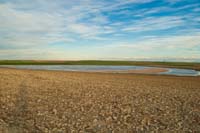
A rest area tells us that some time ago this was the site of the Fuente de Santa Cruz stop for that municipality, in the province of Segovia, some three kilometres away. We cross the AVE line for a third time, this time via a bridge, and here we observe the Caballo de Alba lagoon, part of the Lagoons of Coca and Olmedo which are made up of a number of minor wetlands, some saline, and which are a refuge for a many species of birds.
A little later, just past kilometre point 67, the trail crosses road VP-1106, which provides access to Fuente-Olmedo, already in the province of Valladolid. Finally, some three kilometres further on, an interpretive panel marks the end of the third and final section of the Valle del Eresma Greenway Nature Trail, just 600m from Olmedo, the perfect end to this adventure along the old railway route.
Sites of interest
Map
Puntos de Interés
Profile
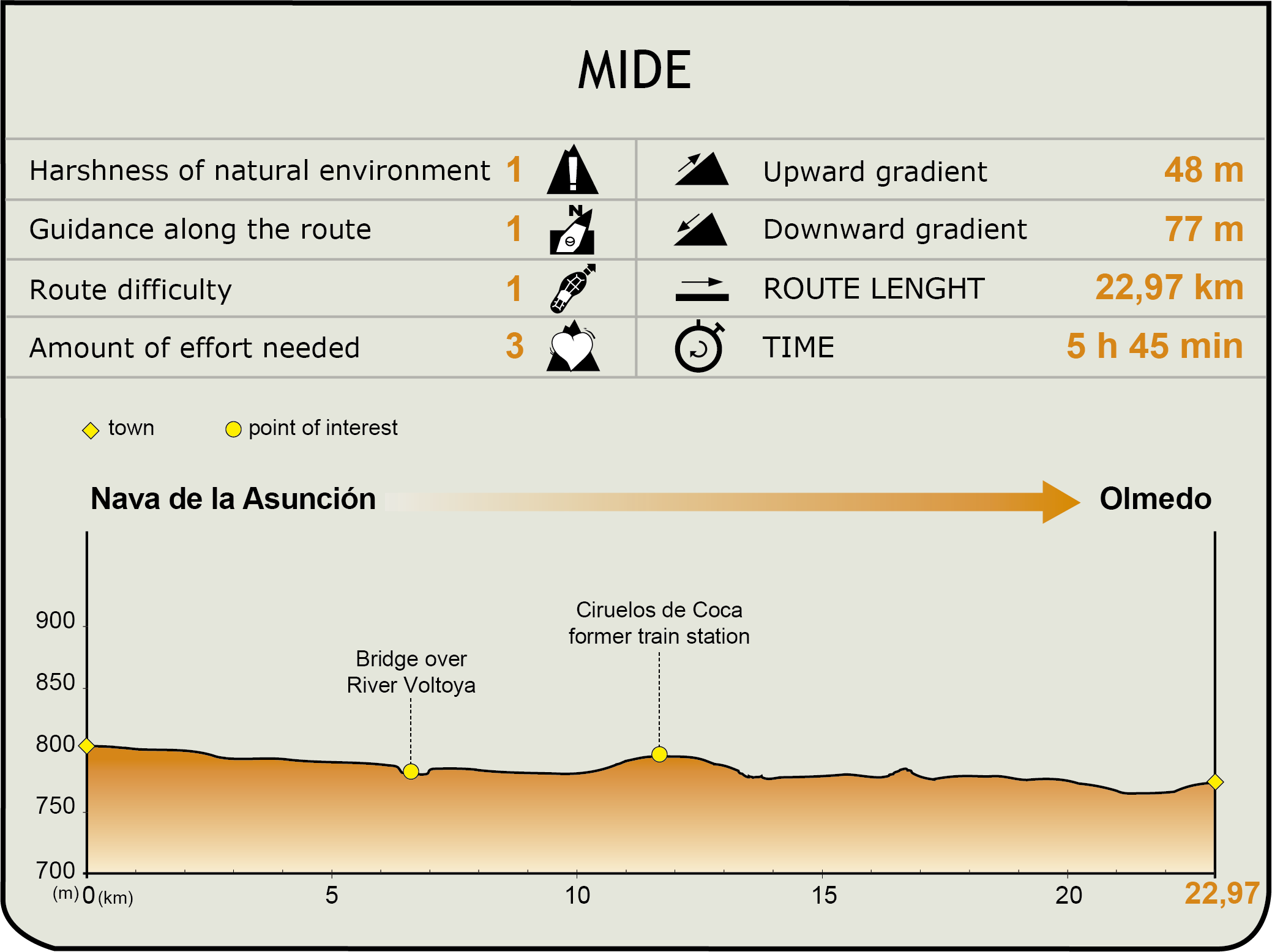
MIDE (Method for the Information of Excursions)
Featured
Further information
Olmedo
Olmedo is located in the province of Valladolid and owes its name to the number of olmos or elm trees that dominated this area in the past.
In terms of its history, studies indicate that a pre-Roman tribe the Vaccaei were the first to settle in the lands which today comprise the municipality of Olmedo. After a period of Arab rule, Olmedo, much like other neighbouring villages, was repopulated with Christian troops in the 11th century. This area was the site of one of the first key battles waged in the Middle Ages. It was here that Peter the Cruel arrived, fleeing from his wife; he was a major figure in the struggle between Aragón and Castile in the 14th century and in the 15th century the came under the control of the then princess Isabella the Catholic. Although if there is anything that has immortalised the name of this village in the Spanish popular imagination, it was Lope de Vega's work El caballero de Olmedo.
Its rich past has left the town an important architectural legacy to be enjoyed by locals and visitors alike. Among the outstanding buildings is its walled centre, whose original construction dates back to the 11th century. The old access gates to the town are also highlights: the San Miguel gate and the Villa arch. In the 15th century the old palace was built, as was the Cárcel de la Chancillería prison, known as the Casa del Reloj or clock house, which would later be reformed in the 18th century.
There is also a significant religious heritage in Olmedo. There impressive churches and monasteries throughout the municipality. Among the best are the churches of San Andrés, San Miguel and San Juan, and the monastery of Santa María de la Mejorada whose chapel was declared a Site of Cultural Interest in 1931.
Other attractions in Olmedo include the Mudéjar Theme Park where you can admire a display of 20 scale models that highlight the rich Mudéjar heritage of Castilla y León.
In terms of the local festivals, one of the dates for your diary in Olmedo is the Classic Theatre Festival in the Villa del Caballero which takes place in July.
The area also holds festivals in honour of its patron saints, San Miguel and San Jerónimo, on the 29th and 30th September. And over the years, the residents of Olmedo have held other festivities such as the coronation of Nuestra Señora la Virgen de Soterraña and the Santa Águeda pilgrimage.
Cyclability
| Stretch(km) | Degree of cyclability | |
| 0,0 to 23 | High | |